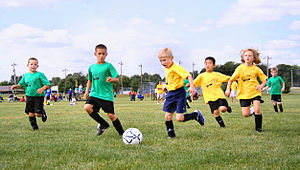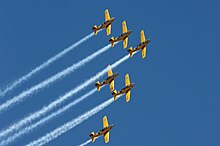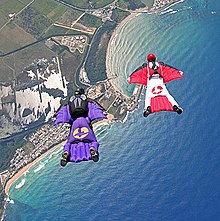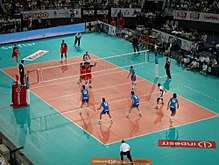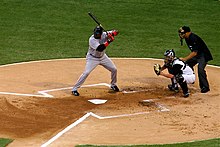Sport
For other uses, see Sport .
Sport (UK) or sports (US) are all forms of usually competitive physical activity or games which,[1] through casual or organised participation, aim to use, maintain or improve physical ability and skills while providing entertainment to participants, and in some cases, spectators.[2] Usually the contest or game is between two sides, each attempting to exceed the other. Some sports allow a tie game; others provide tie-breaking methods, to ensure one winner and one loser. A number of such two-sided contests may be arranged in a tournament producing a champion. Many sports leagues make an annual champion by arranging games in a regular sports season, followed in some cases by playoffs. Hundreds of sports exist, from those between single contestants, through to those with hundreds of simultaneous participants, either in teams or competing as individuals. In certain sports such as racing, many contestants may compete, each against all with one winner.
Sport is generally recognised as activities which are based in physical athleticism or physical dexterity, with the largest major competitions such as the Olympic Games admitting only sports meeting this definition,[3] and other organisations such as theCouncil of Europe using definitions precluding activities without a physical element from classification as sports.[2] However, a number of competitive, but non-physical, activities claim recognition as mind sports. The International Olympic Committee (through ARISF) recognises both chess and bridge as bona fide sports, and SportAccord, the international sports federation association, recognises five non-physical sports,[4][5] although limits the number of mind games which can be admitted as sports.[1]
Sports are usually governed by a set of rules or customs, which serve to ensure fair competition, and allow consistent adjudication of the winner. Winning can be determined by physical events such as scoring goals or crossing a line first. It can also be determined by judges who are scoring elements of the sporting performance, including objective or subjective measures such as technical performance or artistic impression.
Records of performance are often kept, and for popular sports, this information may be widely announced or reported in sport news. Sport is also a major source of entertainment for non-participants, with spectator sport drawing large crowds to sport venues, and reaching wider audiences through broadcasting. Sports betting is in some cases severely regulated, and in some cases is central to the sport.
According to A.T. Kearney, a consultancy, the global sporting industry is worth up to $620 billion as of 2013.[6] The world's most accessible and practised sport is running, while association football is its most popular spectator sport.[7][8]
Contents
[hide]- 1Meaning and usage
- 2History
- 3Fair play
- 4Participation
- 5Issues and considerations
- 6See also
- 7References
- 8Further reading
- 9External links
List of sports
From Wikipedia, the free encyclopediaThe following is a list of sports/games, divided by category. There are many more sports to be added. This system has a disadvantage because some sports may fit in more than one category.According to the World Sports Encyclopedia (2003), there are 8,000 indigenous sports and sporting games.[1]Contents
[hide]- 1Physical sports
- 1.1Air sports
- 1.2Archery
- 1.3Ball-over-net games
- 1.4Basketball family
- 1.5Bat-and-ball (safe haven)
- 1.6Baton twirling
- 1.7Board sports
- 1.8Catch games
- 1.9Climbing
- 1.10Cycling
- 1.11Combat sports: Wrestling and martial arts
- 1.12Cue sports
- 1.13Dance
- 1.14Equine sports
- 1.15Fishing
- 1.16Flying disc sports
- 1.17Football
- 1.18Golf
- 1.19Gymnastics
- 1.20Handball family
- 1.21Hunting
- 1.22Ice sports
- 1.23Kite sports
- 1.24Mixed discipline
- 1.25Orienteering family
- 1.26Pilota family
- 1.27Racquet (or racket) sports
- 1.28Remote control
- 1.29Running
- 1.30Sailing
- 1.31Snow sports
- 1.32Shooting sports
- 1.33Stacking
- 1.34Stick and ball games
- 1.35Street sports
- 1.36Tag games
- 1.37Walking
- 1.38Wall-and-ball
- 1.39Aquatic & paddle sports
- 1.40Weightlifting
- 1.41Motorized sports
- 1.42Marker sports
- 2Mind sports
- 3Different classification
- 4Miscellaneous sports
- 5See also
- 6References
Physical sports
Air sports
Main article: Air sports- Gliding
- Hang gliding
- Human powered aircraft
- Model aircraft
- Parachuting
- Paragliding
- Paramotoring
- Ultralight aviation
Archery
Main article: ArcheryBall-over-net games
- Badminton
- Ball badminton
- Biribol
- Bossaball
- Fistball
- Footbag net
- Football tennis
- Footvolley
- Hooverball
- Peteca
- Pickleball
- Platform tennis
- Sepak takraw
- Sipa
- Tennis
- Throwball
- Volleyball
- Wallyball
Basketball family
Bat-and-ball (safe haven)
Main article: Bat-and-ball- Baseball
- Bat and trap
- British baseball - four posts
- Brännboll - four bases
- Corkball - four bases (no base-running)
- Cricket - two creases
- Danish longball
- Kickball
- Kilikiti
- Lapta – two salos (bases)
- The Massachusetts Game – four bases
- Matball
- Oina
- Old cat – variable
- Over-the-line – qv
- Palant
- Pesäpallo – four bases
- Punchball
- Rounders – four bases or posts
- Scrub baseball – four bases (not a team game per se)
- Stickball – variable
- Stool ball – two stools
- Tee-ball
- Town ball – variable
- Vigoro – two wickets
- Wireball
- Wiffleball
- Bucketball
Baton twirling
Baton twirling
- Fire baton twirling
Board sports
Main article: Board sportsSports that are played with some sort of board as the primary equipment.Catch games
- Curving
- Dodgeball
- Ga-ga
- Keep away
- Kin-Ball
- Newcomb ball
- Quidditch
- Rundown (aka Pickle)
- Yukigassen
Climbing
Main article: Climbing- Rock climbing
- Aid climbing
- Ice climbing
- Mixed climbing
- Abseiling
- Mountaineering
- Other
- Canyoning (Canyoneering)
- Hiking
- Rope climbing
- Pole climbing
- Coasteering
Cycling
Main article: CyclingBicycle
Main article: Bicycle- Artistic cycling
- BMX
- Cyclo-cross
- Cross-country mountain biking
- Cycle polo
- Cycle speedway
- Downhill mountain biking
- Dirt jumping
- Freestyle BMX
- Hardcourt Bike Polo
- Road bicycle racing
- Track cycling
- Underwater cycling
Skibob
Unicycle
Main article: UnicycleBadminton
This article is about the sport. For other uses, see BadmintonBadminton is a recreational sport played using racquets to hit a shuttlecock across a net. Although it may be played with larger teams, the most common forms of the game are "singles" (with one player per side) and "doubles" (with two players per side). Badminton is often played as a casual outdoor activity in a yard or on a beach; formal games are played on a rectangular indoor court. Points are scored by striking the shuttlecock with the racquet[1] and landing it within the opposing side's half of the court. Each side may only strike the shuttlecock once before it passes over the net. Play ends once the shuttlecock has struck the floor or if a fault has been called by the umpire, service judge, or (in their absence) the opposing side.[2]The shuttlecock is a feathered or (in informal matches) plastic projectile which flies differently from the balls used in many other sports. In particular, the feathers create much higher drag, causing the shuttlecock to decelerate more rapidly. Shuttlecocks also have a high top speed compared to the balls in other racquet sports.Rules
The following information is a simplified summary of badminton rules based on the BWF Statutes publication, Laws of Badminton.[13]Court
The court is rectangular and divided into halves by a net. Courts are usually marked for both singles and doubles play, although badminton rules permit a court to be marked for singles only.[13] The doubles court is wider than the singles court, but both are of same length. The exception, which often causes confusion to newer players, is that the doubles court has a shorter serve-length dimension.The full width of the court is 6.1 metres (20 ft), and in singles this width is reduced to 5.18 metres (17 ft). The full length of the court is 13.4 metres (44 ft). The service courts are marked by a centre line dividing the width of the court, by a short service line at a distance of 1.98 metres (6 ft 6 inch) from the net, and by the outer side and back boundaries. In doubles, the service court is also marked by a long service line, which is 0.76 metres (2 ft 6 inch) from the back boundary.The net is 1.55 metres (5 ft 1 inch) high at the edges and 1.524 metres (5 ft) high in the centre. The net posts are placed over the doubles sidelines, even when singles is played.The minimum height for the ceiling above the court is not mentioned in the Laws of Badminton. Nonetheless, a badminton court will not be suitable if the ceiling is likely to be hit on a high serve.Serving
When the server serves, the shuttlecock must pass over the short service line on the opponents' court or it will count as a fault.At the start of the rally, the server and receiver stand in diagonally opposite service courts (see court dimensions). The server hits the shuttlecock so that it would land in the receiver's service court. This is similar to tennis, except that a badminton serve must be hit below waist height and with the racquet shaft pointing downwards, the shuttlecock is not allowed to bounce and in badminton, the players stand inside their service courts unlike tennis.When the serving side loses a rally, the serve immediately passes to their opponent(s) (this differs from the old system where sometimes the serve passes to the doubles partner for what is known as a "second serve").In singles, the server stands in their right service court when their score is even, and in her/his left service court when her/his score is odd.In doubles, if the serving side wins a rally, the same player continues to serve, but he/she changes service courts so that she/he serves to a different opponent each time. If the opponents win the rally and their new score is even, the player in the right service court serves; if odd, the player in the left service court serves. The players' service courts are determined by their positions at the start of the previous rally, not by where they were standing at the end of the rally. A consequence of this system is that, each time a side regains the service, the server will be the player who did not serve last time.Scoring
Main article: Scoring system development of badmintonEach game is played to 21 points, with players scoring a point whenever they win a rally regardless of whether they served[13] (this differs from the old system where players could only win a point on their serve and each game was played to 15 points). A match is the best of three games.If the score reaches 20-all, then the game continues until one side gains a two-point lead (such as 24–22), except when there is a tie at 29-all, in which the golden point comes into play. Whoever scores this point will win.At the start of a match, the shuttlecock is cast and the side towards which the shuttlecock is pointing serves first. Alternatively, a coin may be tossed, with the winners choosing whether to serve or receive first, or choosing which end of the court to occupy, and their opponents making the leftover the remaining choice.In subsequent games, the winners of the previous game serve first. Matches are best out of three: a player or pair must win two games (of 21 points each) to win the match. For the first rally of any doubles game, the serving pair may decide who serves and the receiving pair may decide who receives. The players change ends at the start of the second game; if the match reaches a third game, they change ends both at the start of the game and when the leading player's or pair's score reaches 11 points.The server and receiver must remain within their service courts, without touching the boundary lines, until the server strikes the shuttlecock. The other two players may stand wherever they wish, so long as they do not block the vision of the server or receiverCricket
This article is about the sport. For the insect, see Cricket (insect). For other uses, see Cricket"Cricketer" redirects here. For other uses, see CricketerCricket is a bat-and-ball game played between two teams of 11 players each on a field at the centre of which is a rectangular 22-yard-long pitch. The game is played by 120 million players in many countries, making it the world's second most popular sport.[1][2][3] Each team takes its turn to bat, attempting to score runs, while the other team fields. Each turn is known as aninnings (used for both singular and plural).The bowler delivers the ball to the batsman who attempts to hit the ball with his bat away from the fielders so he can run to the other end of the pitch and score a run. Each batsman continues batting until he is out. The batting team continues batting until ten batsmen are out, or a specified number of overs of six balls have been bowled, at which point the teams switch roles and the fielding team comes in to bat.In professional cricket, the length of a game ranges from 20 overs (T20) per side to Test cricket played over five days. TheLaws of Cricket are maintained by the International Cricket Council (ICC) and the Marylebone Cricket Club (MCC) with additional Standard Playing Conditions for Test matches and One Day Internationals.[4] - 1Physical sports
